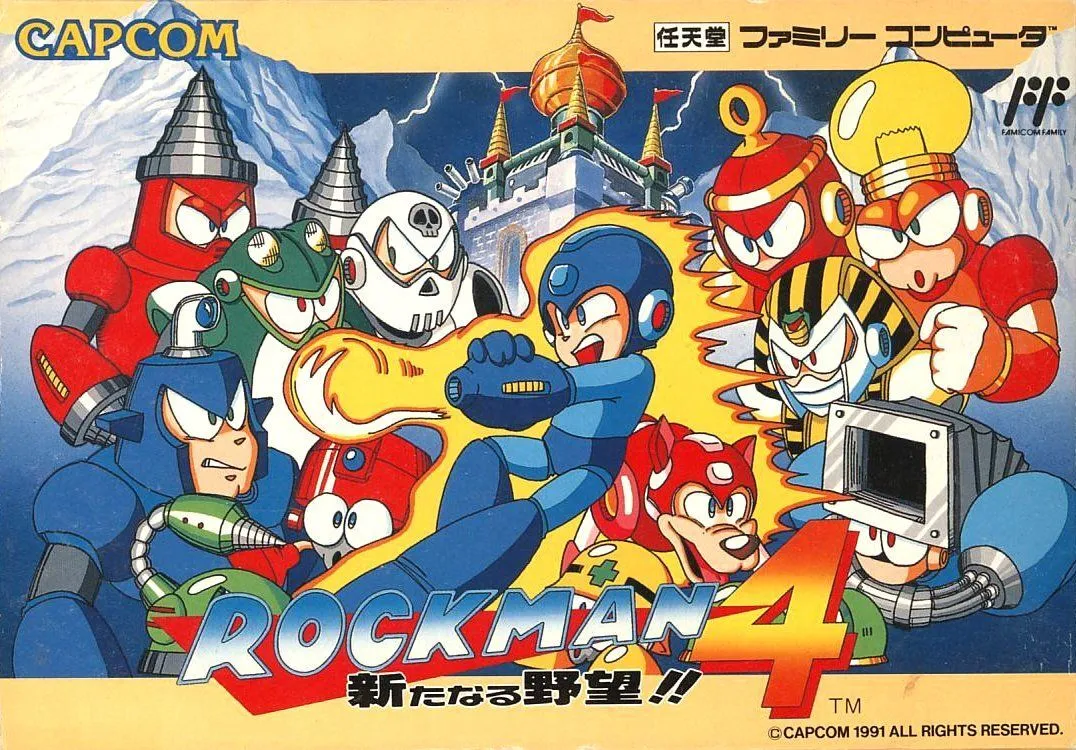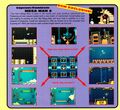Mega Man 4 (lost prototype builds of Famicom/NES game; 1991): Difference between revisions
ShadowMan44 (talk | contribs) mNo edit summary |
No edit summary |
||
| Line 5: | Line 5: | ||
|status=<span style="color:red;">'''Lost'''</span> | |status=<span style="color:red;">'''Lost'''</span> | ||
}} | }} | ||
'''''Mega Man 4''''' is the fourth installment of Capcom's ''Mega Man'' series which follows Mega Man going up against a new villain "Dr. Cossack". The game released in Japan on December 6th, 1991 and overseas somewhere in 1992. The game had numerous prototype builds showcased within 1991 leading up to the release in December. | '''''Mega Man 4''''' is the fourth installment of Capcom's ''Mega Man'' series which follows Mega Man going up against a new villain "Dr. Cossack". The game released in Japan on December 6th, 1991 and overseas somewhere in 1992. The game had numerous prototype builds showcased within 1991 leading up to the release in December. | ||
The earliest prototype | The earliest prototype was shown off at the Tokyo Toy Show in May of that year, showing off many differences including an unfinished stage select screen. The gaming magazine ''Electronic Gaming Monthly'''s 25th issue, showcases screenshots of the Tokyo Toy Show build without much visible progress. Consumer Software Group had shown gameplay in its Autumn-Winter edition as well, showing that the game had progressed further than the Tokyo Toy Show build. ''Weekly Famitsu Magazine'' issue No. 151 shows an advertisement for the game, showing only 2 screenshots that differ slightly from the final release. In its 153rd issue, the game is covered in more detail, with its build likely being the same as 2 issues earlier. Just before the release, Capcom made a promotional video showcasing the game, which had very minor differences. | ||
==Differences Between the Prototype and Final Game== | ==Differences Between the Prototype and Final Game== | ||
In the Tokyo Toy Show build, we can see that the stage select screen was unfinished at that point, not showing any portrait icons for any of the bosses nor any of their names. Bright Man's stage was shown to have different enemy placements as well as different graphics for the background. Many other stages had shown different graphics and layout differences as well, most notable being Ring Man's stage. The footage | In the Tokyo Toy Show build, we can see that the stage select screen was unfinished at that point, not showing any portrait icons for any of the bosses nor any of their names. Bright Man's stage was shown to have different enemy placements as well as different graphics for the background. Many other stages had shown different graphics and layout differences as well, most notable being Ring Man's stage. The footage also showed off a sphinx-themed mini-boss in Pharaoh Man's stage, something that many prototype builds showed off but did not appear in the final game. | ||
In the Consumer Software Group footage, Bright Man's stage has more visible progress closer to the final build, albeit with some missing enemies. Skull Man's stage appears to have different cloud graphics as well as different graphics for a cannon-like enemy. The only other notable difference in this build is that Toad Man's stage lacks rain, whether the physics were implemented or not is currently unknown. | In the Consumer Software Group footage, Bright Man's stage has more visible progress closer to the final build, albeit with some missing enemies. Skull Man's stage appears to have different cloud graphics as well as different graphics for a cannon-like enemy. The only other notable difference in this build is that Toad Man's stage lacks rain, whether the physics were implemented or not is currently unknown. | ||
In the ''Famitsu'' magazine article, the game was shown to be very near to | In the ''Famitsu'' magazine article, the game was shown to be very near to its final build, with only a few minor differences in the level designs. Some enemy placements are different, as well as very minor background elements. | ||
In the Capcom Promotional Video, the game appears to be the closest to | In the Capcom Promotional Video, the game appears to be the closest to its final build, with very few differences, mainly graphical. Most notable graphical difference is the screen that shows Dr. Wily's fortress, which had been completely redrawn in the final build. | ||
==Status== | ==Status== | ||
| Line 25: | Line 24: | ||
<gallery> | <gallery> | ||
<gallery mode=packed heights=175px> | <gallery mode=packed heights=175px> | ||
MM4BrightManAEarly.png|Early screenshot of Bright Man's stage. | |||
MegaMan4Sphinx.png|The Sphinx boss that was cut from Pharaoh Man's stage shown in the Tokyo Toy Show footage. | |||
MM4RingManGEarly.png|Early screenshot of Ring Man's stage, showing off different background graphics. | |||
Electronic_Gaming_Monthly_Issue_025_August_1991_page_044.jpg|Magazine scan of Electronic Gaming Monthly Issue no. 25, dated August 1991. | |||
</gallery> | </gallery> | ||
| Line 45: | Line 44: | ||
==Sources== | ==Sources== | ||
* [https://tcrf.net/Prerelease:Mega_Man_4 General prerelease information and screenshots] Retrieved 15 Sept '24 | *[https://tcrf.net/Prerelease:Mega_Man_4 General prerelease information and screenshots] Retrieved 15 Sept '24 | ||
[[Category:Lost video games]] | [[Category:Lost video games]] | ||
[[Category:Completely lost media]] | [[Category:Completely lost media]] | ||
Latest revision as of 02:44, 16 September 2024
Mega Man 4 is the fourth installment of Capcom's Mega Man series which follows Mega Man going up against a new villain "Dr. Cossack". The game released in Japan on December 6th, 1991 and overseas somewhere in 1992. The game had numerous prototype builds showcased within 1991 leading up to the release in December.
The earliest prototype was shown off at the Tokyo Toy Show in May of that year, showing off many differences including an unfinished stage select screen. The gaming magazine Electronic Gaming Monthly's 25th issue, showcases screenshots of the Tokyo Toy Show build without much visible progress. Consumer Software Group had shown gameplay in its Autumn-Winter edition as well, showing that the game had progressed further than the Tokyo Toy Show build. Weekly Famitsu Magazine issue No. 151 shows an advertisement for the game, showing only 2 screenshots that differ slightly from the final release. In its 153rd issue, the game is covered in more detail, with its build likely being the same as 2 issues earlier. Just before the release, Capcom made a promotional video showcasing the game, which had very minor differences.
Differences Between the Prototype and Final Game
In the Tokyo Toy Show build, we can see that the stage select screen was unfinished at that point, not showing any portrait icons for any of the bosses nor any of their names. Bright Man's stage was shown to have different enemy placements as well as different graphics for the background. Many other stages had shown different graphics and layout differences as well, most notable being Ring Man's stage. The footage also showed off a sphinx-themed mini-boss in Pharaoh Man's stage, something that many prototype builds showed off but did not appear in the final game.
In the Consumer Software Group footage, Bright Man's stage has more visible progress closer to the final build, albeit with some missing enemies. Skull Man's stage appears to have different cloud graphics as well as different graphics for a cannon-like enemy. The only other notable difference in this build is that Toad Man's stage lacks rain, whether the physics were implemented or not is currently unknown.
In the Famitsu magazine article, the game was shown to be very near to its final build, with only a few minor differences in the level designs. Some enemy placements are different, as well as very minor background elements.
In the Capcom Promotional Video, the game appears to be the closest to its final build, with very few differences, mainly graphical. Most notable graphical difference is the screen that shows Dr. Wily's fortress, which had been completely redrawn in the final build.
Status
Currently, none of the prototype builds have surfaced online.
Gallery
Video Gallery
Sources
- General prerelease information and screenshots Retrieved 15 Sept '24




